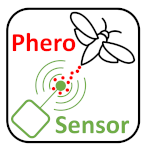Early detection of native and invasive insect pests is an urgent challenge for optimal action before infestation settles. PheroSensor will go beyond the current state-of-the-art solutions of artificial odor sensing by developing and evaluating innovative bioinspired sensors to detect insect pests.
We develop sensors engineered from insect pheromone receptors (PRs), the key actors of insects’ unmatched olfactory performances, to monitor 3 installed or potentially invasive insect pests in France, the fall armyworm and cotton leafworm moths, and the red palm weevil.
Early detection of insect pests is an urgent challenge
Insects communicate with species-specific pheromones :
Pheromones : signals indicating the presence of a given insect species
Pheromones detections : based on highly sensitive and specific receptors
PheroSensor proposes to design, build and test in the field bioinspired sensors, based on insect pheromone receptors, for the early monitoring of invasive insect pests.
The detection of insect-specitifc odors, a new strategy to monitor insect populations
Potential avantages of sensors over traps :
Real-time measure - no insect identification / count
No issue of pheromone stability and emission rate
No attraction of pests from neighboring areas
Not dependent on specific insect behaviors
Sensors should provide more precision to buil risk maps : Precision agriculture
Detection : uniforme treatment, even where there are no pests
Risk maps : adapt and proportionate treatements to the threat = precision agriculture and drastic reduction of pesticide use
Sensors will be based on insect pheromone receptors
Biological sensors
Physical sensors
Project workflow
WP1 Biological sensor
WP2 Physical sensor
WP3 Modelled strategy
WP4 Field studies
Active surveillance of three major invasive insect pests
Red pal weevil, Fall armyworm and Cotton leafworm. Surveillance of all insects communicating with sex or aggregation pheromones.
Pheromone sensors can improve mating disruption
Detection of "white zones" during mating disruption and Optimal positioning of pheromone dispensers.
Indicators of success
Innovative technology : Properties of the sensors and Economic viability for pesticite reduction
Bioinspired sensor : Pheromone receptors are THE receptors designed by Nature to be highly sensitive ans specific to the odors of interest
Cost : Large investments for the demonstrators but reduced costs in the long term
Pheromone receptor production optimized
Low cost achievable for diamond thin films
Diamond surfaces can be reused indefinitely
Electronics mass produced : cheap electronic readout
Impacts :
Short term (5 years) : dissemination on the sensor properties and optimal conditions of their use (papers, softwares, patents,... )
Long term (>20 years) : integration of sensor use on pest management routines, returne on investment (patents)
Insect OR-based sensors have many other potential applications
Insect olfactory receptors are unique in terms of structure and diversity. They detect many other volatile compounds than pheromones.
Coordination: Philippe Lucas, CREA Team, Institute of Ecology and Environmental Sciences of Paris (IEES-Paris), INRAE
